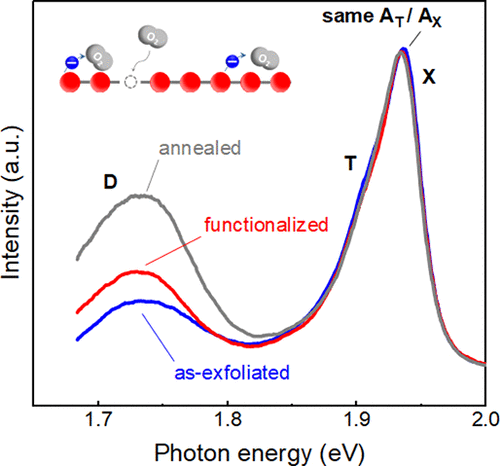当前位置:
X-MOL 学术
›
Nano Lett.
›
论文详情
Our official English website, www.x-mol.net, welcomes your
feedback! (Note: you will need to create a separate account there.)
Intrinsic and Extrinsic Defect-Related Excitons in TMDCs
Nano Letters ( IF 9.6 ) Pub Date : 2020-03-19 , DOI: 10.1021/acs.nanolett.9b05323 Kyrylo Greben 1 , Sonakshi Arora 1 , Moshe G. Harats 1 , Kirill I. Bolotin 1
Nano Letters ( IF 9.6 ) Pub Date : 2020-03-19 , DOI: 10.1021/acs.nanolett.9b05323 Kyrylo Greben 1 , Sonakshi Arora 1 , Moshe G. Harats 1 , Kirill I. Bolotin 1
Affiliation

|
We investigate the excitonic peak associated with defects and disorder in low-temperature photoluminescence of monolayer transition metal dichalcogenides (TMDCs). To uncover the intrinsic origin of defect-related (D) excitons, we study their dependence on gate voltage, excitation power, and temperature in a prototypical TMDC monolayer MoS2. Our results suggest that D excitons are neutral excitons bound to ionized donor levels, likely related to sulfur vacancies, with a density of 7 × 1011 cm–2. To study the extrinsic contribution to D excitons, we controllably deposit oxygen molecules in situ onto the surface of MoS2 kept at cryogenic temperature. We find that, in addition to trivial p-doping of 3 × 1012 cm–2, oxygen affects the D excitons, likely by functionalizing the defect sites. Combined, our results uncover the origin of D excitons, suggest an approach to track the functionalization of TMDCs, to benchmark device quality, and pave the way toward exciton engineering in hybrid organic–inorganic TMDC devices.
中文翻译:

TMDC中内在和外在缺陷相关的激子
我们调查与缺陷和无序相关的在单层过渡金属二卤化金属(TMDCs)的低温光致发光中的激子峰。为了揭示与缺陷相关的(D)激子的内在起源,我们研究了原型DCTM单层MoS 2中它们对栅极电压,激励功率和温度的依赖性。我们的结果表明,D激子是中性激子,与离子化的供体水平结合,可能与硫的空位有关,密度为7×10 11 cm –2。为了研究外源性对D激子的贡献,我们可控地将氧分子原位沉积在保持低温的MoS 2表面上。我们发现,除了3×10的微不足道的p掺杂之外,12 cm –2,氧可能通过使缺陷部位功能化来影响D激子。综合起来,我们的结果揭示了D激子的起源,提出了一种跟踪TMDC功能的方法,以基准测试设备质量,并为有机-无机TMDC混合设备中的激子工程学铺平了道路。
更新日期:2020-04-24
中文翻译:

TMDC中内在和外在缺陷相关的激子
我们调查与缺陷和无序相关的在单层过渡金属二卤化金属(TMDCs)的低温光致发光中的激子峰。为了揭示与缺陷相关的(D)激子的内在起源,我们研究了原型DCTM单层MoS 2中它们对栅极电压,激励功率和温度的依赖性。我们的结果表明,D激子是中性激子,与离子化的供体水平结合,可能与硫的空位有关,密度为7×10 11 cm –2。为了研究外源性对D激子的贡献,我们可控地将氧分子原位沉积在保持低温的MoS 2表面上。我们发现,除了3×10的微不足道的p掺杂之外,12 cm –2,氧可能通过使缺陷部位功能化来影响D激子。综合起来,我们的结果揭示了D激子的起源,提出了一种跟踪TMDC功能的方法,以基准测试设备质量,并为有机-无机TMDC混合设备中的激子工程学铺平了道路。











































 京公网安备 11010802027423号
京公网安备 11010802027423号